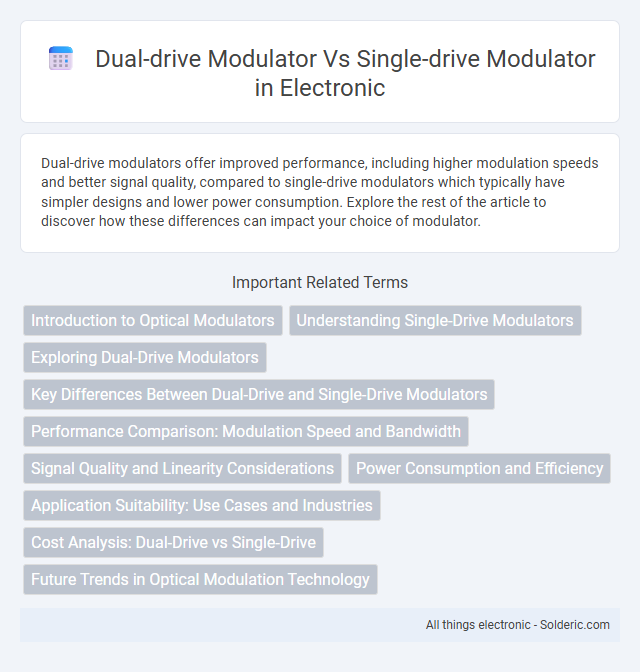Dual-drive modulators offer improved performance, including higher modulation speeds and better signal quality, compared to single-drive modulators which typically have simpler designs and lower power consumption. Explore the rest of the article to discover how these differences can impact your choice of modulator.
Comparison Table
| Feature | Dual-Drive Modulator | Single-Drive Modulator |
|---|---|---|
| Drive Configuration | Two electrodes driven differentially | Single electrode with one drive signal |
| Modulation Efficiency | Higher due to differential drive | Lower efficiency |
| Voltage Requirement | Lower RF voltage needed for same modulation | Higher RF voltage required |
| Linearity | Improved linearity | Lower linearity |
| Bandwidth | Wider bandwidth achievable | Limited bandwidth |
| Complexity | More complex driver circuitry | Simpler design |
| Cost | Higher due to complexity | Lower cost |
| Applications | High-performance optical communication systems | Basic modulation needs |
Introduction to Optical Modulators
Optical modulators control light signals in fiber optic communication, with dual-drive and single-drive modulators being primary types. Dual-drive modulators use two electrodes to achieve better linearity and higher extinction ratio, enhancing signal quality for advanced data transmission. Single-drive modulators have simpler design and lower cost but typically offer less modulation depth and signal integrity compared to dual-drive configurations.
Understanding Single-Drive Modulators
Single-drive modulators use a single RF input to modulate the optical signal, making them simpler in design but often less efficient in performance compared to dual-drive modulators. Their operation relies on applying a voltage to one arm of the Mach-Zehnder interferometer, resulting in phase modulation that directly affects the output signal. Understanding the limitations of single-drive modulators is essential for optimizing your system's bandwidth and signal integrity in photonic communication applications.
Exploring Dual-Drive Modulators
Dual-drive modulators provide enhanced signal integrity and higher modulation efficiency compared to single-drive modulators by utilizing two separate RF inputs to control the optical phase. You benefit from improved linearity and reduced chirp, which are critical for high-speed coherent communication systems. This design optimizes bandwidth utilization and supports advanced modulation formats, making dual-drive modulators ideal for next-generation optical networks.
Key Differences Between Dual-Drive and Single-Drive Modulators
Dual-drive modulators utilize two separate electrical signals to control phase shifts, enabling higher modulation efficiency and better linearity compared to single-drive modulators, which rely on a single electrical input. The enhanced performance of dual-drive modulators results in lower insertion loss and improved extinction ratio, making them ideal for high-speed optical communication systems. Your choice between the two depends on the required signal quality, power consumption, and system complexity.
Performance Comparison: Modulation Speed and Bandwidth
Dual-drive modulators offer higher modulation speeds and broader bandwidth compared to single-drive modulators due to their ability to independently control phase in two arms, resulting in improved linearity and lower signal distortion. Your system can achieve more efficient high-frequency signal processing with dual-drive modulators, which support wider bandwidths essential for advanced optical communication. Single-drive modulators typically exhibit limited modulation speed and narrower bandwidth, making them less suitable for demanding high-speed applications.
Signal Quality and Linearity Considerations
Dual-drive modulators offer enhanced signal quality and improved linearity compared to single-drive modulators by enabling balanced modulation and reducing distortions such as chirp and harmonic generation. The use of two phase modulators driven with complementary signals minimizes nonlinearities, leading to higher fidelity in high-speed optical communication systems. This improved linearity significantly benefits applications requiring precise signal integrity, such as advanced coherent transmission formats and high-bandwidth data links.
Power Consumption and Efficiency
Dual-drive modulators reduce power consumption by distributing the voltage drive across two electrodes, enabling lower voltage swings for the same modulation depth. This design enhances efficiency by minimizing RF power requirements and improving linearity compared to single-drive modulators, which must apply higher voltage to a single electrode. Consequently, dual-drive modulators achieve superior modulation efficiency and reduced thermal stress, making them ideal for high-speed communication systems.
Application Suitability: Use Cases and Industries
Dual-drive modulators excel in high-speed optical communication systems, such as data centers and telecommunication networks, due to their enhanced modulation bandwidth and signal quality. Single-drive modulators find suitability in cost-sensitive applications like short-reach fiber optic systems and access networks where simpler design and lower power consumption are prioritized. Industries including 5G infrastructure, CATV, and metropolitan area networks benefit from dual-drive configurations, while single-drive modulators are commonly deployed in LANs and consumer-grade optical transceivers.
Cost Analysis: Dual-Drive vs Single-Drive
Dual-drive modulators typically incur higher initial costs compared to single-drive modulators due to increased complexity and additional components such as two RF inputs and precision phase control circuitry. However, dual-drive modulators often provide better performance, including lower insertion loss and improved linearity, which can reduce long-term operational expenses by enhancing signal quality and minimizing the need for costly amplification or error correction. When evaluating cost analysis, your choice depends on balancing upfront investment against potential energy savings and system reliability benefits offered by dual-drive technology.
Future Trends in Optical Modulation Technology
Dual-drive modulators offer enhanced bandwidth and improved signal integrity compared to single-drive modulators, making them more suitable for next-generation high-speed optical communication systems. Future trends indicate a shift towards silicon photonics integration with dual-drive configurations to achieve lower power consumption and higher modulation speeds. Advanced modulation formats like PAM4 and coherent modulation benefit significantly from dual-drive modulators' superior phase and amplitude control capabilities.
Dual-drive modulator vs single-drive modulator Infographic

 solderic.com
solderic.com